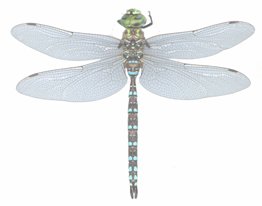 |
| Aeshna
canadensis |
 |
|
Common Name:
|
Canada Darner |
|
Odonata |
|
Order:
|
Odonata |
|
Suborder:
|
Anisoptera |
|
Family:
|
Aeshnidae |
|
Genus:
|
Aeshna |
|
Species:
|
A. canadensis |
|
|
| The
Name |
| Canada Darner, Aeshna canadensis
(Walker, 1908), is a species of dragonfly in family Aeshnidae. It is common
throughout southern Canada and the northern United States. Aeshna canadensis
occurs in ten provinces and one territory in Canada and twenty four states
in the United States of America.
The Canada Darner is a member of
the family Aeshnidae. Darners are among the largest and fastest-flying
North American dragonflies, 2 1/4-4 3/4" (57-120 mm) long. These brilliant
blue, green, or brown insects have large, clear wings spanning up to 5
7/8". Their compound eyes meet on top of the head. The female hovers above
water usually attached or guarded by the male and, using a well-developed
ovipositor for slicing into emergent plants, thrusts eggs one at a time
in the stems. Preferred habitat includes wooded lakes and ponds with abundant
vegetation, as well as marshy and boggy lakes, fens, and slow sluggish
streams often associated with beaver ponds. Wetland systems: Western Emergent
Marsh, Northern Rocky Mountain Wooded Vernal Pool and the Rocky Mountain
Subalpine-Montane Fen.
Very similar to Green-striped Darner.
If the anterior lateral stripe is all blue, the ID is fairly straightforward,
but in as many as 10% of New Jersey males, it is partially or completely
green, similar to Green-striped. In Canada Darner, the notch in this
stripe usually forms a 90 degree or sharper angle. Patrolling Canada Darners
do not look as bright as Green-striped.
Canada Darner usually shows a small
spot between the lateral thoracic stripes, absent in Green-striped Darner.
Unfortunately, some male Canadas, usually the ones that most closely resemble
Green-striped, lack this spot as well. Intermediate individuals must
be ID'd by examination of the cerci under magnification. Many books
tell you that you can feel small bumps on the cerci of Canada, but Green-striped
cerci feel rough as well, although the bumps are smaller.
|
| The
Characteristics |
| Length typically 68-74 mm. The eyes
are blue, blue-gray, or green. The abdomen is very dark with blue spotting
on all the segments. Females are much like the males, but instead of being
blue the markings are green to green-yellow. Sometimes females have amber-tinted
wings.
The Canada Darner is one of 11 species
of Aeshnid darners found in Alberta. Look for this amazing aerialist throughout
summer. The Canada Darner can be found in central and southern Alberta.
Like all Aeshnids, the Canada Darner
exemplifies the aerial supremacy that dragonflies are known for. They possess
the beautiful mosaic pattern of green, blue and yellow markings on the
abdomen that characterize Aeshnid darners. Darners can be difficult to
tell apart. Some clues to the identity of the Canada Darner are that the
face is light green with a light brown line; the last abdominal segment
has pale spots, and the thoracic stripes are bold. The forward edge of
the first stripe is strongly indented with an approximately right-angled
notch in the front edge of the front thorax stripe. There is also a small
spot between the two stripes, at about the same height as the notch. As
with all darners, the large all-seeing eyes touch each other at the top
of the head. The dark wing spots are narrow and elongate.
Often associated with bogs and beaver
ponds; also occurs at lakes and ponds with abundant emergent vegetation
in forest zone. May be found in feeding swarms away from water. Breeds
in squishy ponds, small lakes and slow streams. Males patrol above the
shoreline vegetation, keeping an eye out for females, also for rival males.
Their patrol is usually at a height of about three feet, and they stop
often to hover.
Adults fly from June to October.
|
| The
Reproduction and Development |
| Male Canada Darners patrol relatively
small territories along the water's edge, often hovering for significant
periods before flying into vegetation looking for females. Copulation usually
occurs in vegetation near water. Females oviposit (lay eggs) above the
waterline in the stalks of emergent vegetation, slicing into the plant
with their ovipositor.
Larvae feed on a wide variety of
aquatic insects, such as mosquito larvae, other aquatic fly larvae, mayfly
larvae, and freshwater shrimp. They will also eat very small fish and tadpoles.
Adult- The dragonfly will eat almost any soft-bodied flying insect including
mosquitoes, flies, small moths, mayflies, and flying ants or termites.
|
| The
Distribution |
Abundant in many areas throughout
its range, common all across North America and there is no indication of
any population decline nor are any threats currently identified.
|
| The
Protection Status |
| IUCN Red List as Least Concern.
Common and abundant throughout its range. |
|
References:
http://en.wikipedia.org/wiki/Aeshna_canadensis
http://www.iucnredlist.org/details/165074/0
http://fieldguide.mt.gov/detail_IIODO14020.aspx
|
| The
Species on Stamps |
|
|
|
|
|
|
Home | Country
List | Species List
|
|